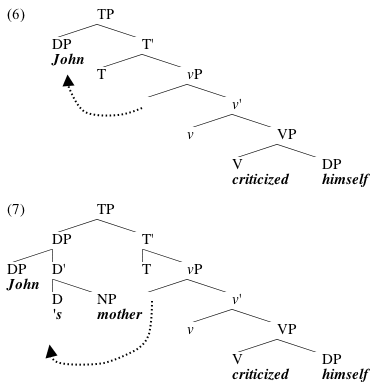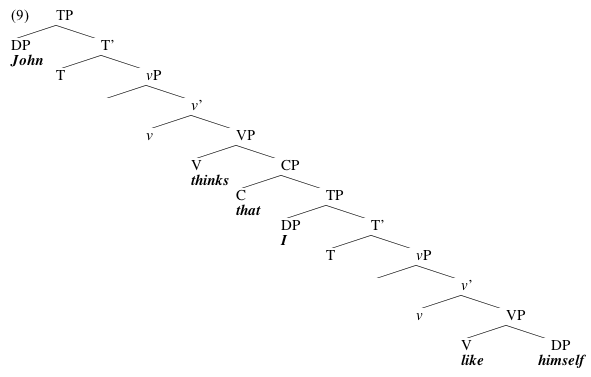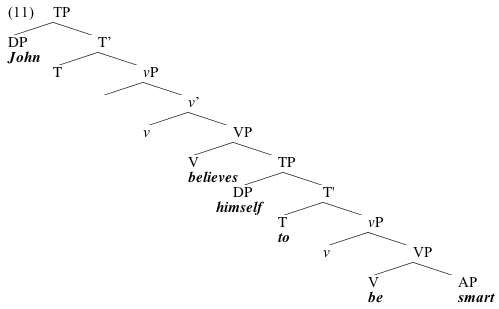
(1) John criticized himself.
(2) John criticized him.
In (1), the word himself has to refer to John; this sentence means that the person that John criticized was John. In (2), on the other hand, him can't refer to John. Of course, this isn't a fact about him in general; that word could refer to John in principle, for example in a sentence like (3):
(3) Mary criticized him.
So there's something crucial about the structure of (2) that makes it impossible for him to refer to John there.
Binding theory is the study of facts like the ones in (1-3). When we're studying facts like these, the standard way of annotating the patterns of possible coreference is with subscripts, like so:
(1)' Johni criticized himselfi/*j
(2)' Johni criticized him*i/j
Here the subscripts indicate that in (1)', for example, himself must refer to John (if John and himself have the same index, the result is well-formed), and cannot refer to anyone else (if we give himself an index that's different from the one on John, we get a *).
We call words like himself anaphors. One special property of anaphors is that they have to corefer with other words in the sentence, as himself does with John in (1). If we deprive this anaphor of something to corefer with, the sentence becomes bad:
(4) *Ii criticized himselfj.
(4) is no good because himself needs to corefer with something 3rd person, singular, and masculine, and I can't satisfy that requirement. The DP that an anaphor is coreferring with--like John in (1)--is called the antecedent of the anaphor. So one way to state what we know so far would be via the following principle:
Principle A (version 1 of 3)
An anaphor must have an antecedent.
It turns out that this Principle A is not specific enough. Consider an example like (5):
(5) *Johni's mother criticized himselfi.
Even though himself has an antecedent in (5), the result is still ill-formed. To figure out how to distinguish between (1) and (5), let's consider trees for these sentences:

Intuitively, the problem with (5) (that is, with (7)) is that John is "too deeply buried" to be the antecedent for this anaphor; it's inside this bigger DP. We can formalize that by defining a relation between nodes in a tree, called c-command:
c-command
α c-commands β iff every node dominating α dominates β.
This is almost equivalent to saying that a node c-commands its sister, and everything its sister dominates. In both of the trees in (6-7), for example, the node v c-commands the VP, and also the V criticized, and the DP himself. To see this, consider all the nodes that dominate v; those are vP, T', and TP. Then to find out what v c-commands, we consider the nodes are dominated by all of these nodes. And these turn out to be VP, V, and DP.
Now we can formalize our intuition that John in (7) is "too deeply buried" to be the antecedent of the anaphor himself. In (6), the DP John c-commands the DP himself; the only node dominating John is TP, and this node also dominates himself (along with the rest of the sentence). But in (7), the DP John doesn't c-command the DP himself; John is dominated both by the DP John's mother and by the TP, and the DP John's mother does not dominate himself. So we can distinguish between (6) and (7) by requiring an anaphor to be c-commanded by its antecedent. In general, we'll say that when one DP c-commands another DP, and the two DPs corefer, that the first DP binds the second DP. And the new version of Principle A can read:
Principle A (version 2 of 3)
An anaphor must be bound.
As it happens, this version of Principle A is not quite restrictive enough, either. Consider (8), which has the tree in (9):
(8) *Johni thinks that I like himselfi.

The anaphor himself is bound in this example; John corefers with himself, and c-commands himself (since the only node dominating John is the matrix TP, and this node also dominates himself, along with everything else in the sentence). One difference, of course, between the well-formed (1) above and this ill-formed example (8) is that John and himself are further away in the ill-formed example than they are in the well-formed example. So apparently it is not enough for an anaphor to be bound; it must be bound by something which is not too far away; there is some kind of locality condition on anaphor binding that we need to try to capture. We call the part of the sentence within which the anaphor must be bound the binding domain of the anaphor.
Principle A (version 3 of 3)
An anaphor must have a binder which is in the anaphor's binding domain.
Now, what determines the size of the binding domain? Just comparing example (1) with example (8), we might come up with something like:
Binding domain (version 1 of 4)
The binding domain of an anaphor α is the smallest TP dominating α.
This definition works for a number of cases, including the examples considered so far. But it has trouble with examples like (10), with the tree in (11):
(10) Johni believes himselfi to be smart.

In the tree in (11), the anaphor himself's binding domain ought to be the embedded TP, himself to be smart. Since the antecedent for the anaphor is outside this TP, we ought to expect (11) to be ill-formed, given our definition of binding domain above.
There are a number of ways to distinguish between (11) and (9), of course. We could claim that only tensed TPs define binding domains, for example, or that binding domains are CPs rather than TPs. Neither of these moves would work very well, however, since they would predict that examples like (12) ought to be well-formed:
(12) *Johni believes me to like himselfi.
If we were to change our definition of 'binding domain' so that the TP complement of believe was just never a binding domain, that would allow binding in (11), but it would also allow it in (12), which we don't want.
It looks like we would be better off appealing to another difference between (1) (and (11)), on the one hand, and (8) (and (12)), on the other; himself can be in a different clause from its binder, but if it is, it had better be the subject of that clause (as it is in (11)). In other words, we could define binding domain as follows:
Binding domain (version 2 of 4)
The binding domain of an anaphor α is the smallest TP containing α and a DP which c-commands α.
This definition gets all the facts we've considered so far. The relevant sentences are listed below, just to group them all in one place:
(1) Johni criticized himselfi
(5) *Johni's mother criticized himselfi.
(8) *Johni thinks that I like himselfi.
(10) Johni believes himselfi to be smart.
(12) *Johni believes me to like himselfi.
Now, there's one more change we ought to make to our definition of binding domain, and then we'll be happy with it as far as anaphors are concerned. We have looked at anaphors which are separated from their antecedents by tensed clause boundaries (as in (8)), and also at anaphors which are in embedded infinitival clauses (as in (10) and (12)). In the infinitival clause cases, we've considered the anaphor both as a possible subject (as in (10)) and as a non-subject (as in (12)). But in finite clauses, we've only looked at examples in which the anaphor is not a subject (that's (8)). To complete the paradigm, then, we ought to look at examples in which the anaphor is the subject of an embedded tensed clause:
(13) *Johni believes that himselfi is smart.
Unfortunately, we seem to get the wrong result here. The anaphor himself in this example is inside an embedded TP, but this TP contains no DP that c-commands the anaphor, and as a result, the embedded TP shouldn't be the binding domain for the anaphor. In other words, we expect (13) to be well-formed; the binding domain for the anaphor ought to be the whole sentence.
At this point, some cross-linguistic perspective is in order. It turns out that the theory we've developed works just fine for a certain anaphor in Chinese (Chinese has several anaphors, which play by somewhat different rules, but we'll concentrate on one of them here). Consider these translations of (1), (5), and (8) into Chinese:
(14) Zhangsani piping ta-zijii Zhangsan criticize himself 'Zhangsan criticized himself' (15) * Zhangsani -de mama piping ta-zijii Zhangsan 's mother criticize himself 'Zhangsan's mother criticized himself' (16) * Zhangsani renwei wo hen xihuan ta-zijii Zhangsan think I very like himself 'Zhangsan thinks I like himself'As you can see, these Chinese examples have the same grammaticality status as their English translations; apparently the Chinese anaphor ta-ziji is very similar to the English anaphor himself in its distribution. But there is one striking difference between the two languages; Chinese allows examples like (13):
(17) Zhangsani renwei ta-zijii hen congming Zhangsan think himself very smart 'Zhangsan thinks that himself is smart'Examples like (17) are okay in Chinese, just as our theory predicts they ought to be. So the binding theory that we have works quite well for Chinese, though we have seen that it may have problems with English. It looks as though we would be making a mistake if we were to radically alter our definition of binding domain to rule out examples like (13) in English. Rather, we need to add a second clause to the definition, which apparently is a point of linguistic variation:
Binding domain (version 3 of 4)
The binding domain of an anaphor α is:
This two-part definition looks cumbersome, but it allows us to express the variation between languages like English and languages like Chinese.
Now, the discussion throughout has centered mostly on anaphors--in fact, on one particular anaphor, himself. Himself is what's called a reflexive, an anaphor which simply refers to its antecedent (other anaphors are myself, yourself, ourselves, etc.). The other major class of anaphors are reciprocals, like each other, which also needs to be bound in its binding domain but has a more complicated semantic contribution to the sentence:
(18) [John and Mary]i criticized each otheri.
(19) *[John and Mary]i think that I criticized each otheri.
Binding theory also constrains the behavior of pronouns:
(20) *Johni likes himi.
(21) Johni thinks that I like himi.
In (20), him is unable to refer to John, while in (21), John and him can corefer. If we change him to himself, we get the opposite judgments:
(21) Johni likes himselfi.
(22) *Johni thinks that I like himselfi.
We now have a theory of the facts in (21-22), and developing a theory of the facts in (20-21) should be fairly straightforward; all we need to do is add a new principle governing the behavior of pronouns:
Principle B
A pronoun must be free in its binding domain.
And we also need to make the definition of binding domain less specific, so that not just anaphors, but any DP can have a binding domain:
Binding domain (version 4 of 4)
The binding domain of a DP α is:
These definitions predict that pronouns and anaphors ought to always be in complementary distribution; they have the same binding domains, and in those binding domains, anaphors must be bound and pronouns must be free. This is almost true, but not quite; there are a few contexts in which both pronouns and anaphors seem to be acceptable, at least for some speakers:
(23) Johni saw a snake near himi/himselfi.
(24) Johni thinks that pictures of himi/himselfi will sell well.
So apparently there is something about pronouns that we're not yet understanding, and we'll leave it at that for now.
| Optional Reading: Here's an overview of the history of binding theory, up to the early 90's (Harbert, Wayne. 1995. "Binding theory, control, and pro." In Gert Webelhuth, ed., Government and Binding Theory and the Minimalist Program, pp. 177-217. Blackwell, Oxford.) And here's a somewhat different approach to binding theory (Reinhart, Tanya, and Eric Reuland. 1993. Reflexivity. Linguistic Inquiry 24.657-720. |
Finally, there's one last type of nominal to consider. We have a way of ruling out (25), but not of ruling out (26):
(25)*Johnilikes himi.
(26)*Heilikes Johni.
(25) violates Principle B: the pronoun him is bound in its binding domain. But what about (26)? Here the pronoun he is free. Apparently we need something to constrain the behavior of DPs like John; that is, we need a condition on DPs which are neither anaphors nor pronouns. Such DPs are called R-expressions.
One way to handle (26) would be to extend Principle B so that it covers R-expressions as well as pronouns. But that would be a mistake, as we can see in (27) and (28):
(27) Hei thinks I like himi.
(28) *Heithinks I like Johni.
In (27), the pronoun him obeys Principle B; the pronoun is bound, but not in its binding domain. But in (28), we can see that the R-expression is still unhappy, even though its binder is outside its binding domain. Apparently we need a third principle for R-expressions:
Principle C
R-expressions must be free.